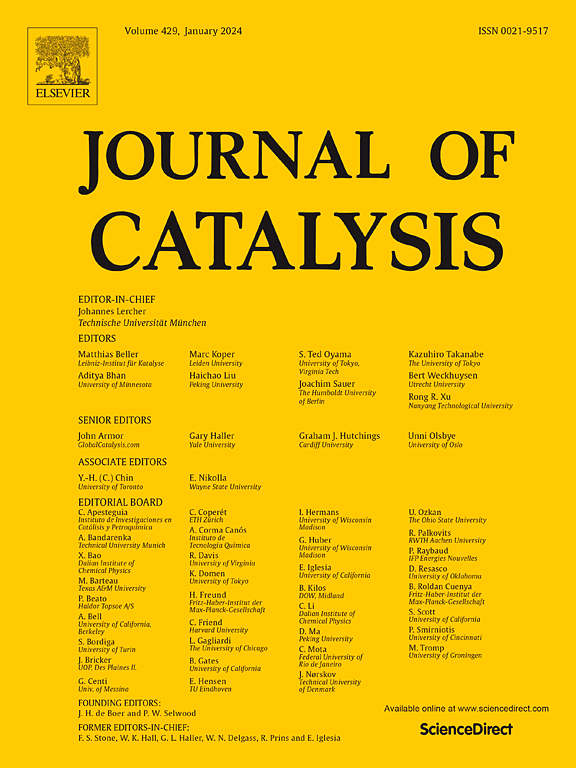Fluorination modulates the interaction of water with MgO catalysts during propylene glycol dehydrogenation
IF 6.5
1区 化学
Q2 CHEMISTRY, PHYSICAL
引用次数: 0
Abstract
The influence of water on catalytic reactions and catalysts is an unavoidable point of concern in biomass valorization. In this study, we develop a fluorine-modified magnesium oxide catalyst (MgO-F) and explored the role of fluorine in the dehydrogenation of propylene glycol to hydroxyacetone in the presence of water. MgO-F is a mixed phase of magnesium oxide, magnesium fluoride, and oxyfluoride structure, resulting in changes to its electronic properties and consequently to its acidity and alkalinity. Detailed kinetics suggested that fluorine accelerates the dehydrogenation reaction rate while increasing the selectivity to allyl alcohol and propanol in absence of water. Increasing water pressure lowers the apparent barriers but hardly alters the reaction order of propylene glycol on MgO-F catalyst. In contrast, the MgO catalyst exhibits lower reaction orders and increased activation barriers under similar conditions. Further kinetic isotope effect (KIE) studies showed that the water actively participates in the reaction on MgO catalyst, whereas on the MgO-F catalyst negligible effects were observed. This weaker interaction with water led to improved stability and reduced kinetic sensitivity towards water. These results demonstrate the ability of fluorine to tailor the interaction of water molecules with metal oxide surfaces, which ultimately modifies the activity, selectivity, and stability of the catalyst.


氟化调节丙二醇脱氢过程中水与氧化镁催化剂的相互作用
水对催化反应和催化剂的影响是生物质增值研究中不可避免的问题。在本研究中,我们开发了一种氟改性氧化镁催化剂(MgO-F),并探讨了氟在水存在下丙二醇脱氢制羟基丙酮中的作用。氧化镁-氟化镁是氧化镁、氟化镁和氟氧化物结构的混合相,导致其电子性质发生变化,从而改变其酸碱度。详细的动力学表明,氟加速了脱氢反应的速度,同时增加了对烯丙醇和丙醇的选择性。增加水压力降低了表观障碍,但几乎没有改变丙二醇在MgO-F催化剂上的反应顺序。相比之下,MgO催化剂在相同条件下表现出较低的反应阶数和较高的激活势垒。进一步的动力学同位素效应(KIE)研究表明,水在MgO催化剂上积极参与反应,而在MgO- f催化剂上的影响可以忽略不计。这种与水的弱相互作用提高了稳定性,降低了对水的动力学敏感性。这些结果表明氟能够调节水分子与金属氧化物表面的相互作用,从而最终改变催化剂的活性、选择性和稳定性。
本文章由计算机程序翻译,如有差异,请以英文原文为准。
求助全文
约1分钟内获得全文
求助全文
来源期刊

Journal of Catalysis
工程技术-工程:化工
CiteScore
12.30
自引率
5.50%
发文量
447
审稿时长
31 days
期刊介绍:
The Journal of Catalysis publishes scholarly articles on both heterogeneous and homogeneous catalysis, covering a wide range of chemical transformations. These include various types of catalysis, such as those mediated by photons, plasmons, and electrons. The focus of the studies is to understand the relationship between catalytic function and the underlying chemical properties of surfaces and metal complexes.
The articles in the journal offer innovative concepts and explore the synthesis and kinetics of inorganic solids and homogeneous complexes. Furthermore, they discuss spectroscopic techniques for characterizing catalysts, investigate the interaction of probes and reacting species with catalysts, and employ theoretical methods.
The research presented in the journal should have direct relevance to the field of catalytic processes, addressing either fundamental aspects or applications of catalysis.
 求助内容:
求助内容: 应助结果提醒方式:
应助结果提醒方式:


